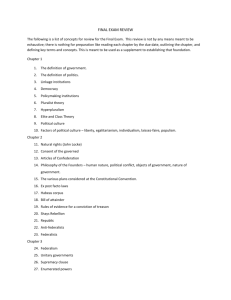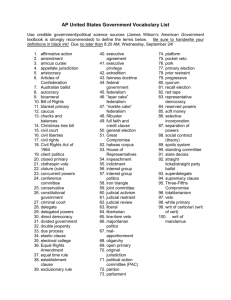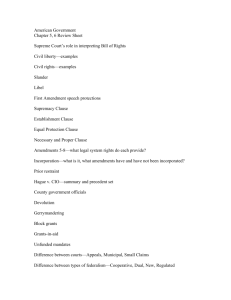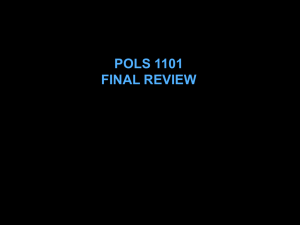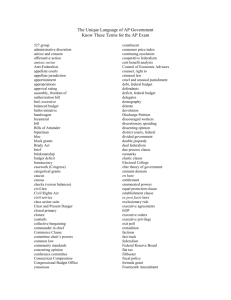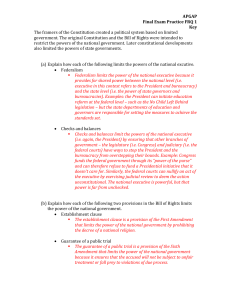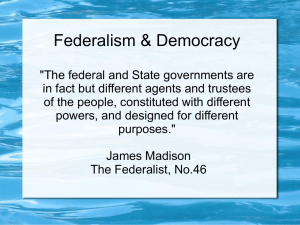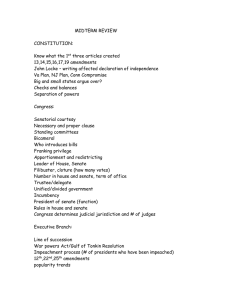GOVT_2305_FINAL_EXAM_STUDY_GUIDE_Fall_2014
advertisement
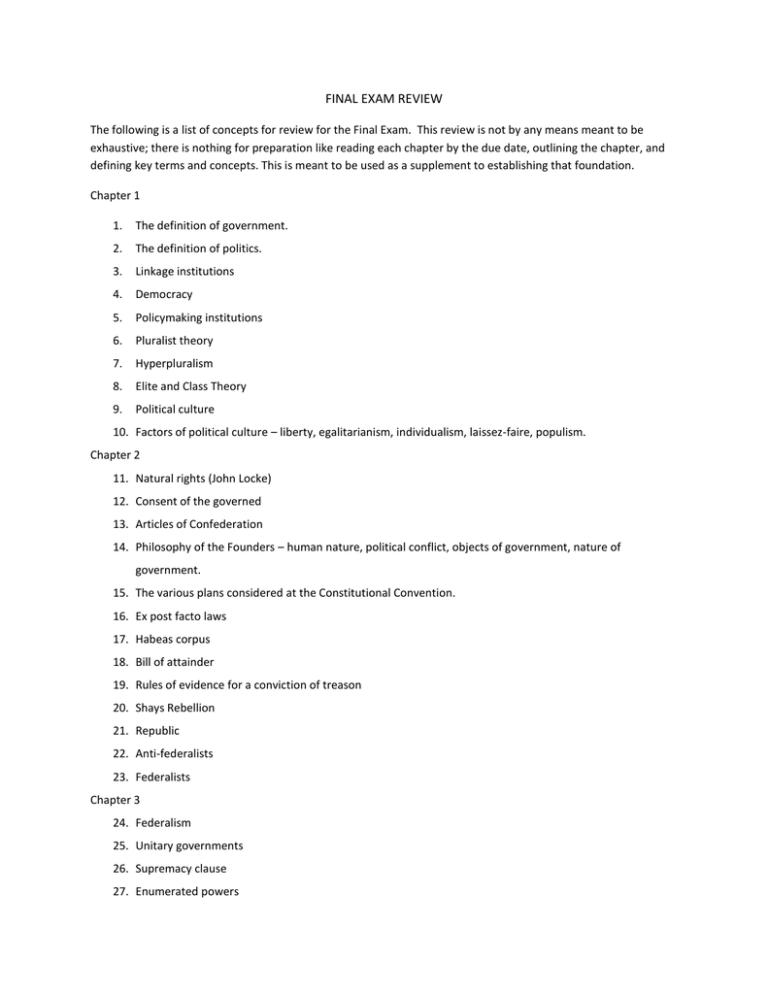
FINAL EXAM REVIEW The following is a list of concepts for review for the Final Exam. This review is not by any means meant to be exhaustive; there is nothing for preparation like reading each chapter by the due date, outlining the chapter, and defining key terms and concepts. This is meant to be used as a supplement to establishing that foundation. Chapter 1 1. The definition of government. 2. The definition of politics. 3. Linkage institutions 4. Democracy 5. Policymaking institutions 6. Pluralist theory 7. Hyperpluralism 8. Elite and Class Theory 9. Political culture 10. Factors of political culture – liberty, egalitarianism, individualism, laissez-faire, populism. Chapter 2 11. Natural rights (John Locke) 12. Consent of the governed 13. Articles of Confederation 14. Philosophy of the Founders – human nature, political conflict, objects of government, nature of government. 15. The various plans considered at the Constitutional Convention. 16. Ex post facto laws 17. Habeas corpus 18. Bill of attainder 19. Rules of evidence for a conviction of treason 20. Shays Rebellion 21. Republic 22. Anti-federalists 23. Federalists Chapter 3 24. Federalism 25. Unitary governments 26. Supremacy clause 27. Enumerated powers 28. Implied powers 29. Full faith and credit 30. Extradition 31. Dual federalism 32. Cooperative federalism 33. Devolution Chapter 4 34. Civil liberties 35. The Stoning of Soraya M. movie 36. The Pharr Riot video 37. Incorporation doctrine 38. Due process clause 39. Establishment clause 40. Free exercise clause 41. Lemon v. Kurtzman 42. Engel v. Vitale 43. Libel and Slander 44. Prior restraint 45. Obscenity 46. Symbolic speech 47. Commercial speech 48. Miranda v. Arizona 49. Know what rights each of the amendments in the Bill of Rights protect. 50. Roe v. Wade 51. Probable cause 52. Unreasonable search and seizures 53. Exclusionary rule 54. Plea bargaining 55. Cruel and unusual punishment Chapter 6 56. Demography 57. Melting pot 58. Minority majority 59. Political socialization 60. Sample 61. Random sampling 62. Sampling error 63. Political ideology 64. Gender gap 65. Protest, civil disobedience, violence Chapter 8 66. Rational-choice theory 67. Party identification 68. Ticket splitting 69. Party machines 70. Patronage 71. National convention, National committee, national chairperson 72. Critical election, party realignment 73. Party dealignment 74. Responsible party model 75. Blue dog democrats Chapter 10 76. Primary elections, general elections, referendums 77. Political efficacy 78. Civic duty 79. Electoral college 80. Retrospective voting Chapter 12 81. Incumbents 82. Credit claiming – casework and pork barrel 83. Filibuster 84. Speaker of the House 85. Majority leader and minority leader 86. Standing committee, select committee, conference committee 87. Congressional caucus 88. Bill Chapter 13 89. Twenty-second Amendment 90. Impeachment 91. Watergate 92. Cabinet 93. Veto, pocket veto 94. Presidential coattails 95. War powers resolution Chapter 16 96. Litigant 97. Standing to sue 98. Class action suits 99. Justiciable disputes 100. Stare decisis 101. Precedent 102. Original jurisdiction 103. Appellate jurisdiction 104. Judicial implementation 105. Amicus curiae brief 106. The Golden Circle video 107. The Supreme Court – how many justices, the rule of four. 108. The Death Penalty in the U.S. 109. Terms of Justices and Federal Judges 110. Senatorial Courtesy Chapter 18 111. Entitlement programs 112. Poverty line 113. Means-tested programs 114. Feminization of poverty 115. Progressive and regressive taxes 116. Income and wealth 117. Relative deprivation Chapter 19 118. Medicare and Medicaid 119. HMOs 120. National Health Insurance 121. Global Warming Chapter 11 122. Potential group 123. Actual group 124. Collective good 125. Free-rider problem 126. Selective benefits 127. Single-issue groups 128. Political Action Committees (PACS) Culture and Government 129. Uncertainty avoidance 130. Power distance 131. Individualism 132. Indulgence 133. Masculinity
